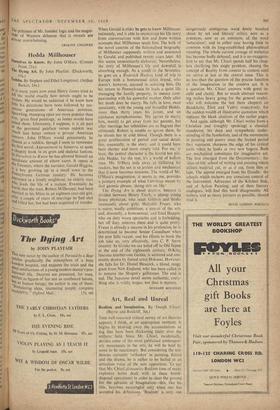Hedda Millhouser
IT is many years now since Henry James tried to tell the world exactly how novels ought to be Written. He would be saddened if he knew bow Little his directions have been followed by suc- cessive generations of American novelists. 8Prawling, thumping epics are more popular than e‘er, 'great fluid puddings,' as James would have called them. Ultimately, I suppose, it is all part °t the perennial paleface versus redskin war Which had better remain a private American concern. John O'Hara would presumably be eil.assed as a redskin, though I seem to remember UIS first novel, Appointment in Satnarra, as quite a, shapely book in its grim and skeletal fashion. Ourselves to Know he has allowed himself an Inordinate amount of elbow room. It opens in t.he Twenties, where the narrator, Gerald Higgins, 1,! a boy growing up in a small town in the eansylvania German country. He becomes Interested in a kindly neighbour, an elderly man ho leads the life of a recluse. Eventually he ‘carns that the man, Robert Millhouser, had been h 7, carried in his fifties to an eighteen-year-old girl; "ter a couple of years of marriage he had shot and killed her, but had been acquitted of murder. When Gerald is older he gets to know Millhouser intimately, and is able to reconstruct his life story from conversations with him and from written accounts that Millhouser sends him. The bulk of the novel consists of the fictionalised biography of Millhouser supposedly written and annotated by Gerald, and published twenty years later. All this seems unnecessarily elaborate. Nevertheless, the story of Millhouser's life and downfall is absorbing enough. As a youth in the Seventies, he goes on a Roderick Hudson kind of trip to Europe with a homosexual artist friend, who doesn't, however, succeed in seducing him. On his return to Pennsylvania he leads a quiet life managing the family property, in uneasy com- panionship with his powerful mother. Only after her death does he marry. He falls in love, most unsuitably, with the young and beautiful Hedda, more than thirty years his junior, and an assiduous nymphomaniac. She agrees to marry him, mainly to get away from her parents, but after marriage her infidelities are so flagrant that ultimately Robert is unable to ignore them. So he shoots her in cold blood. Though there is a great proliferation of period and social detail, this, essentially, is the story, and it could have been shorter and more simply told. For me, at least, the central character is the horrid but piti- able Hedda; for the rest, it's a world of hollow men. Mr. O'Hara toils away at titillating his readers, but the sex is so joyless and mechanical that it soon becomes tiresome. The world of Mr. O'Hara's imagination, it seems to me, provides a palmary example of what Law rence meant by that gnomic phrase, 'doing dirt on life.' The Dying Art is about doctors. Interest is divided between Henry Tinch, a plump young house physician, who reads Gibbon and thinks incessantly about girls; Malcolm Fraser, who is suave, madly ambitious, a patron of the arts and, discreetly, a homosexual; and Enid Happin, who on duty wears spectacles and is forbidding, but off duty removes them and is quite pretty. Fraser is already a success in his profession, he is determined to .become Senior Consultant when the post falls vacant, and his efforts to hook the job take us, very effectively, into C. P. Snow country. In Geisha we are haled off to Old Japan at the end of the eighteenth century. 0-Kita, luscious number-one Geisha, is admired and con- stantly drawn by famed artist Hokusai. However, she falls for Dr. Daniel Heacock, a blond, rangy giant from New England, who has been called in to remove the Shogun's gallstones. The end is sad. The Japanese detail seems authentic, every- thing else is wildly bogus, not that it matters.
BERNARD BERGONZI


































 Previous page
Previous page